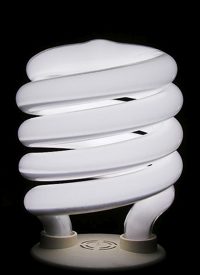
For millions of environmental activists the Compact Fuorescent Light bulb (CFL) has become a popular mascot rivaling the World Wildlife Fund’s panda bear symbol. Corporations, governments, and NGOs have jumped on board General Electric’s green CFL bandwagon, singing the praises of the now-familiar curly lamps.
Many companies seeking to burnish their green bonafides celebrated Earth Day 2010 on April 22 by handing out CFLs in their communities. One such business is Harrah’s Entertainment, the giant Las Vegas-based casino/resort company. A company press release distributed over PR Newswire states:
In celebration of Earth Day 2010, more than 400 employee volunteers from Harrah’s Entertainment resorts across the country plan to distribute 50,000 energy-efficient light bulbs in local communities.
Compact Fluorescent Light Bulbs (CFLs) are environmentally friendly and reduce energy costs substantially with compared conventional incandescent light bulbs. The 50,000 bulbs will reduce more than 45 million pounds of greenhouse gas emissions and save more than $400,000 in energy costs.
But are CFLs "environmentally friendly"? Each bulb contains a small amount of mercury. You know, the element that greenies get hysterical over when even miniscule traces show up in tuna or other seafood. They insist that coal-fired electrical plants must be shut down because they produce relatively small amounts of mercury. Yet, many of the same activists are advocating that billions of traditional incandescent light bulbs be replaced with mercury-containing CFLs. In fact, they joined with GE in a multi-million dollar lobbying campaign to pressure Congress to mandate that Americans must switch all of our light bulbs. But what happens to the environment when billions of CFLs are disposed of in landfills? And what happens when one breaks a CFL in the home, office, hospital, or school classroom?
Rep. Ted Poe (R-Texas) addressed the House of Representatives concerning some of the practical problems, as well as the constitutional problems, with the federal legislation mandating CFL usage. Rep. Poe reads from the federal Environmental Protection Agency (EPA) regulations concerning the mercury dangers, CFL disposal procedures, and clean-up procedures for a broken CFL, in this video.
But in addition to the rising concern over the mercury content of CFLs, which portends serious disposal and consumer health issues, can be added a new concern: serious health concerns due to the "dirty electricity" from the electromagnetic waves generated by CFLs. A recent segment of the "Be Green" environmental program for the Montreal station of the Canadian Broadcasting Corporation (CBC) looked at concerns by health experts over the serious impact CFL usage is already having on people suffering from diabetes, multiple sclerosis, and asthma. Many people will find these results startling … and sobering.
There is also evidence that CFLs may cause migraine headaches, as the neurologist in this news video contends.
Whether or not the health and environmental dangers from CFLs turn out to be as serious as CFL critics contend, the episode underscores the folly of unintended consequences in allowing Congress to legislate in areas where it has no competence — and equally, if not more important, no constitutional authority — for doing so.


